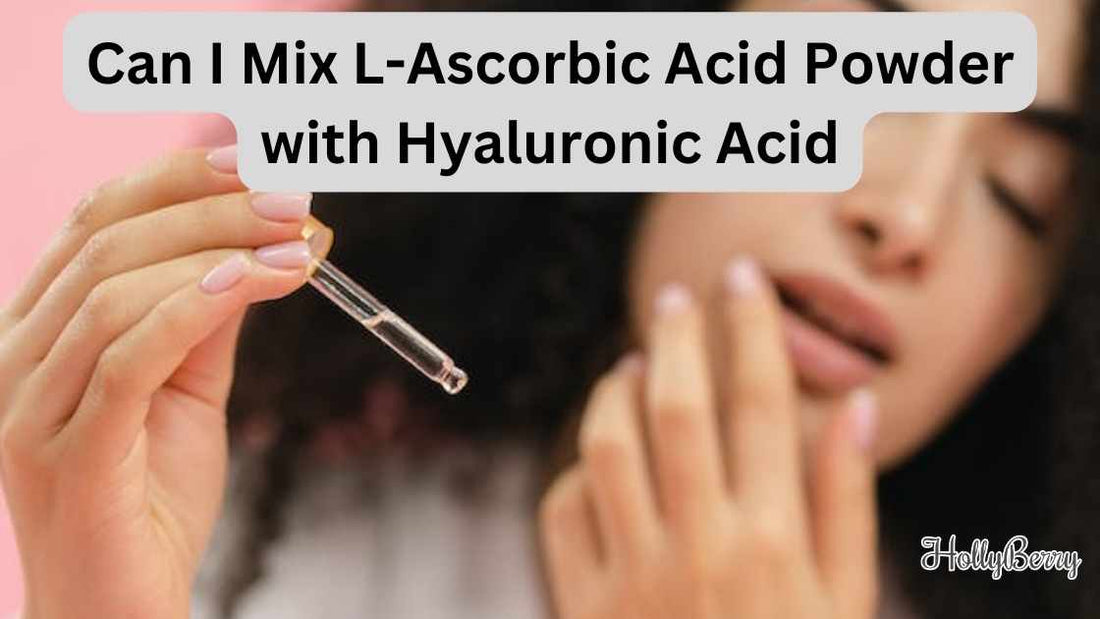
Can I Mix L-Ascorbic Acid Powder with Hyaluronic Acid
Share
Unveiling Skincare Synergy

In the dynamic world of skincare, ascorbic acid powder, commonly known as vitamin C, has gained much acclaim for its potent antioxidant properties.
Skincare enthusiasts often seek to incorporate it into their daily routine for its benefits in brightening skin, reducing signs of ageing, and protecting against environmental stressors.
One of the common questions that arise is whether it is feasible to mix ascorbic acid powder with hyaluronic acid, another skincare staple renowned for its intense hydration capabilities.
Hyaluronic acid serves as a humectant, attracting moisture into the skin, which can enhance the skin’s texture and plumpness.
When considering the combination of ascorbic acid powder and hyaluronic acid, compatibility and efficacy are key factors. They are indeed frequently combined in skincare formulations, signalling a compatibility that suggests combining them could yield synergistic effects.
Theoretically, when used together, these ingredients could offer comprehensive skin benefits—ascorbic acid provides its antioxidative power while hyaluronic acid contributes to optimal skin hydration.
It remains crucial, however, for individuals to understand how to properly mix these ingredients to maintain their integrity and maximise their effects within a skincare routine.

Order our Vitamin C and Hyaluronic acid serum
Combining Skincare Ingredients
When incorporating active skincare ingredients into a routine, it is vital to understand their properties and how they interact.
This section explores the synergistic relationship between L-Ascorbic Acid and Hyaluronic Acid, detailing the science behind their pairing, the skin benefits they offer together, and the best practices for mixing them.
Understanding Ascorbic Acid and Hyaluronic Acid
L-ascorbic acid, known widely as Vitamin C, is a potent antioxidant that helps protect the skin from environmental damage, reduces signs of ageing, and improves pigmentation issues.
Typically found in skincare products as a water-soluble powder, ascorbic acid works best when applied at a low pH level to ensure stability and absorption. On the other hand, Hyaluronic Acid is a hydrating compound, naturally present in the skin, which retains a remarkable amount of water to keep the skin plump and well-hydrated.
The Benefits of Mixing L-Ascorbic Acid with Hyaluronic Acid
Mixing L-ascorbic acid with Hyaluronic Acid can provide comprehensive skin benefits. The antioxidant properties of L-ascorbic acid help to protect the skin against oxidative stress, while its ability to promote collagen synthesis aids in reducing the appearance of fine lines.
Hyaluronic Acid brings to this combination its intense hydrating capability, assisting in maintaining skin moisture and elasticity, which complements the texture-improving effects of ascorbic acid.
Proper Mixing Techniques and Ratios
To reap the combined benefits of L-ascorbic acid and Hyaluronic Acid, correct mixing techniques and ratios are essential.
- Create a solution using distilled water at a pH of around 3.5 to dissolve the ascorbic acid powder effectively, ensuring maximum efficacy of the Vitamin C.
- The ideal concentration of L-ascorbic acid in home mixtures should not exceed 20% to minimise skin irritation.
- Once the ascorbic acid has fully dissolved, it can be combined with a Hyaluronic Acid serum. It is important to ensure the Hyaluronic Acid is not oil-based, as L-ascorbic acid is water-soluble and does not mix well with oils.
- The two should be applied immediately after mixing to avoid degradation of ascorbic acid.
When layering different skincare products, such as these, allow each layer to absorb into the skin to optimise benefits. Always perform a patch test when using new combinations to ensure skin compatibility.
Incorporating Into a Skincare Regimen
Incorporating L-ascorbic acid powder with hyaluronic acid in your skincare routine requires careful consideration with respect to timing, complementary products, and potential ingredient conflicts.
Precautions When Using L-Ascorbic Acid
When adding L-ascorbic acid to a skincare regimen, it is essential to conduct a patch test beforehand to ensure no adverse reactions occur. This potent form of Vitamin C is an antioxidant, which, while offering skin brightening and protective benefits, can cause irritation in some individuals, especially when not stabilised.
Morning Vs Evening Applications
The use of L-ascorbic acid is usually recommended for the morning to harness its antioxidant properties, aiding in protection against free radicals and UV rays throughout the day.
However, it can be applied in the evening regimen as well, paired with hyaluronic acid, which serves as a hydrator and can help buffer the acid's potency. When incorporating into an AM routine, always follow with a definitive layer of sunscreen.
Synergistic Products and Potential Conflicts
L-ascorbic acid functions well alongside other antioxidants and hydrators such as The Ordinary's hyaluronic acid. While it can be combined with hyaluronic acid, it may conflict with niacinamide, retinoids, peptides, AHAs, direct acids, and specific oils, potentially reducing efficacy or causing irritation.

